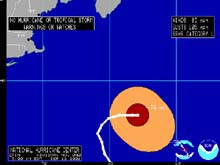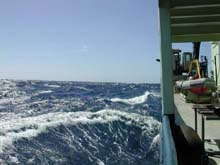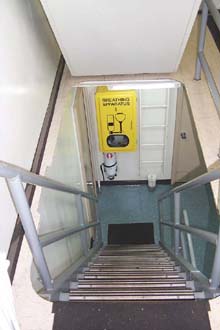Mitigating the Billows
September 12, 2001
Diana Payne
The Maritime Aquarium at Norwalk/
Connecticut Sea Grant
"Vessels large may venture more, but little boats should keep near shore." -- Benjamin Franklin, Poor Richard's Almanac
"The pilot cannot mitigate the billows or calm the winds." -- Plutarch, Of The Tranquility of the Mind
"Attention all hands, attention all hands. No one is allowed on the weather decks until further notice."
-- Gary Chiljean, Master, R/V Atlantis, Sept. 12, 2001

The location of Hurricane Erin at 5 am EDT this morning was too close for comfort for the Deep East science team. Click image for larger view.
Through late Tuesday and early Wednesday, the R/V Atlantis headed east toward the next dive site, Bear Seamount. Swells from 15-18 ft and near 40-knot winds have made routine tasks, including sleeping, more difficult. Lying in my bunk below the main deck, I feel as though I am on a very strange amusement park ride. Movement is up and down, but also in a unique circular motion, like that of the demonstration of wave movement, showing a ball in a wave. There seems to be pressure pushing me down into my bunk. Water occasionally slams against the ship with a great boom, and there is a rhythmic, tin-like sound echoing through the hull.
The dive at Bear Seamount has been cancelled. We feel the effects of Hurricane Erin, now approximately 150 mi to the southeast. The storm has slowed somewhat, but it is hoped that a high-pressure system from the west will move her along on her eastward path. Erin began as a tropical disturbance and progressed to a tropical depression nearly a week prior to the start of the Deep East Expedition. The storm gained strength, then began to slow, and it seemed that our expedition would not be affected. Then, however, Erin increased in intensity again, and began to move northwest toward Bermuda. Forecasts placed the hurricane's path away from land and "safely out to sea."
Hurricanes in the northern hemisphere occur primarily in late summer and early fall, with peak activity occurring during the month of September. A hurricane begins as a tropical disturbance, due in part to the large amount of moisture in the air and the large amount of latent heat rising from the surface of the ocean as evaporation. The resulting moist, unstable air rises to form clouds. As the central pressure falls and the winds begin to flow circularly around the low pressure, a tropical depression is formed. The eye begins to form, characterized by little or no clouds, warmer temperatures, and lighter winds. Sustained winds are less than 65 km/hr.
A tropical storm occurs when the central pressure drops and the wind speeds reach 65-120 km/hour. A hurricane is formed when sustained winds exceed 120km/hour. The hurricane is "fueled" as the sun heats the ocean water and evaporation occurs. This latent heat causes the air to rise quickly, and is the major driving force of a hurricane. The warm, moist air continues to "feed" the hurricane. As a hurricane moves over land or into colder waters, it begins to lose strength. Hurricanes do not form over the equator, as there is not enough force due to the rotation of the Earth (the Coriolis effect) to cause a storm to rotate. This planetary "spin" is necessary for the circular motion of a hurricane to form.
Work aboard the R/V Atlantis continues. The crew goes about their duties, watches change, meals are prepared and eaten, and scientists continue to review footage from Monday's dive. Coral specimens are analyzed. E-mail and news updates regarding events in New York City and Washington, DC are still the focal point of daily discussions. As we reach the midpoint of Leg 1 of Deep East, we are mindful of the events that have taken place ashore, and anxiously await our reunion with family and friends.
Sign up for the Ocean Explorer E-mail Update List.


































